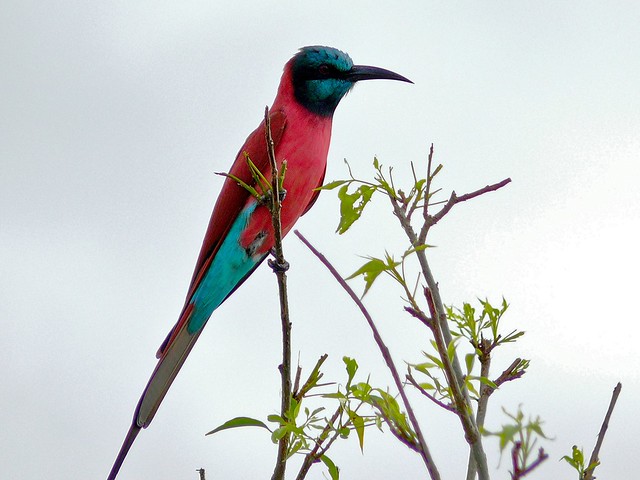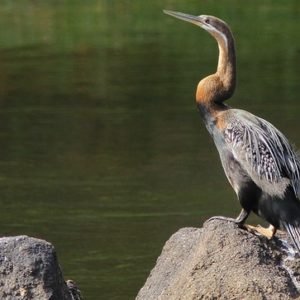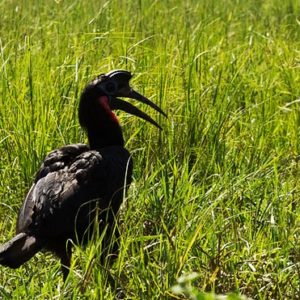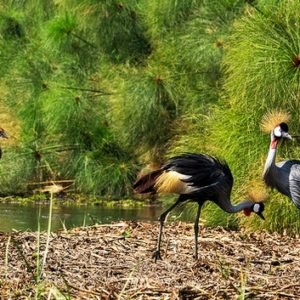Murchison falls is among Uganda’s best birding spots with over 451 bird species which include; Albertine rift endemic birds, water birds, and savannah birds. Viewing birds in the scenic landscape and amazing wildlife of Murchison is among the most interesting experiences while on a Ugandan safari. The park is located in the Northwestern part of the country about 305 km from Kampala hence approximately a 4 hours drive by road.
There are very many birds in the park of which some are rare, common, and occasional such as the Gray crowned crane(Uganda’s National bird), Giant Kingfisher, Giant Heron, Shoebill stork, Abyssinian Ground Hornbills, Nightjars, Marabou stork, Black headed lapwing, Back-bellied Bustard among others.

Birds in Murchison can be best spotted while on a game drive, nature walks through the savannah grasslands and on the boat cruise along the Nile and on Lake Albert Delta. Birds like the blue napped mouse birds, silver birds, weavers among others can be spotted near Paraa and Red chilli in through the dry thorn-shrubs. Nocturnal birds like the nightjars can be seen along the Paraa road and while on the boat on the Nile. While on the boat still very many birds such as the shoebill, Gray crowned cranes, Goliath herons, black headed lapwings among others can be spotted.
Best time for birding 
Birders can watch birds all year round though best time is during the dry season in months especially from January-March, this time is a low tourist season in Uganda but birding is still plentiful. From December-February the rains begin and birding can still be done.
From April-May and from August-October there are heavy rains, which makes it difficult for bird watching since the hiking trails become slippery and roads in the park become impassable.
The shoebill is the park’s most outstanding attraction though rare but can be spotted from January to March during the dry season. Migratory birds can be seen between months November and April.
List of some of the birds found in Murchison falls
- Shoe bill
 African Darter
African Darter- Giant Kingfisher
- Osprey
- Long-toed Plover
- Grey-headed Kingfisher
- Veracious Dove
- Black-headed Lapwing
- Abyssinian Ground Hornbill
- Rock Pratincole
- Yellow-fronted Tinkerbird
- Black-billed Barbet
- Long-tailed Nightjar

- Weaver Birds
- Yellow-billed Stork
- Martial Eagle
- Silver bird
- Gray crowned crested crane
- Sandpipers
- Pied Kingfishers
- Standard-winged Nightjar
- Malachite Kingfishers
- Blue-headed Coucal
- Denham’s Bustard
 Swamp Flycatcher
Swamp Flycatcher- Giant Heron
- African Jacana
- Secretary Bird
- Read-throated Bee eater
- Saddle-billed stork
- Senegal Thick-Knee
- Red winged Grey Warbler
What to carry
Birders are expected to have a birder’s guide book, a pointer, a pair of binoculars, Sun glasses, hats, sturdy shoes(during hikes), and enough water.
Suggested Uganda Safaris 2025

3 Days Queen Elizabeth Safari Uganda This 3-day adventure in Queen Elizabeth National Park will take you to Uganda’s second

Safari Overview The 3 Day Safari in Murchison Falls National Park takes you the most popular as well as the

This 4 Days safari will take you to southwestern Uganda to visit the Bwindi impenetrable forest home of the mountain

Safari Overview This safari begins in Kampala and takes you to the Bwindi impenetrable National Park where you will get

This 6 days Safari offers a good combination of gorilla trekking in the bwindi impenetrable National Park and game viewing

This 7-day Uganda safari adventure takes you to Kibale National Park also known as the primate capital of eat Africa

This 8 day Uganda Safari begins in Kampala and will take you to Murchison Falls National Park for a thrilling

Safari Overview This 9 Day Uganda gorilla and wildlife Safari will take you to the Murchison Falls National Park the

This 11 Day Safari takes you to Uganda’s largest National Park – the Murchison Falls National Park through which the

This 12-day Safari in Uganda offers you the best of Uganda rich wildlife abundance, beautiful scenery and a unique cultural

This 13 Day Uganda and Rwanda Gorilla Wildlife Safari gives you total encounter of the amazing wildlife in Uganda –

This 14 Days Best of Uganda Safari takes you to Ngamba Islands home of the rescued and orphaned chimpanzees found

On this 15 Day Uganda Safari, get a chance to Experience Uganda’s rich wildlife abundance, beautiful scenery, and remarkable cultural

This expedition takes you to Mgahinga Gorilla park in Uganda for a Golden monkey habituation experience. Mgahinga gorilla park sits

This cost-effective Uganda Fly-in 3-day gorilla excursion includes a flight from Entebbe to your gorilla trek in Uganda’s Bwindi Impenetrable

This 4-day Uganda tour visits Murchison Falls National Park, one of Uganda’s oldest wildlife reserves. Murchison is considered a premier

This will be an exceptional 4-day Kidepo Valley road tour to Africa’s genuine wilderness. Kidepo Valley National Park is Uganda’s

4 Days Gorilla Encounter and Queen Elizabeth Wildlife Tour in Uganda (Starting from Kigali, Rwanda) This 4-day gorilla and wildlife

The 4 Days Uganda gorilla trekking and Lake Bunyonyi adventure begins from Kampala- Uganda’s capital and concludes in Kampala. This

Golden Monkey Habituation Experience, Gorilla Tracking Uganda in Mgahinga Gorilla National Park and Lake Mburo National Park Safari in Uganda

Cost Of 5 Days Chimpanzee in Kibale & Gorillas in Bwindi Safari The going rate for a five‑day road trip

Experience Queen Elizabeth National Park in Uganda and Bwindi Forest National Park for an exhilarating Wildlife and Gorilla Safari in

Safari overview This 5 Days Uganda gorilla tour and tree climbing lions takes you on a remarkable Uganda safari to

Safari Overview The 5 days fly-in wildlife safari in Kidepo national park is an exceptional Uganda adventure that transports you

HIGHLIGHTS: DAY 1: Airport pickup and journey to Kibale National Park. Evening Bigodi community exploration. DAY 2: Kibale national park

This 6 days Uganda gorillas and tree-climbing lions safari guides you to Bwindi Impenetrable National Park, which houses half of

Average Cost Of 6 Days Safari in Uganda Budget travellers can expect to spend approximately US $1,800 per person for

This Uganda safari blends gorilla trekking in Bwindi Forest with wildlife expeditions in Murchison Falls National Park, Uganda’s largest national

This 7-Days Uganda Wildlife And Primate Experience Safari commences and concludes at Entebbe international airport in Uganda. This remarkable Uganda

This exhilarating week-long Uganda safari begins with a journey to Uganda’s premier tourist destination – Bwindi Impenetrable National Park. Beyond

This 7 Day Big five wildlife safari offers a combined adventure in Murchison Falls NP and Kidepo Valley NP. The

8 Days Uganda Safari Cost Budget eight‑day Great Apes safaris in Uganda start at US $1,000 per person for minimal‑inclusive

Your 9-day Uganda safari to explore the country’s natural treasures will be a remarkable journey. You’ll delve into the core

Cost For 9 Days Kidepo and Bwindi Fly in Safari Budget rates for a nine‑day Kidepo & Bwindi fly‑in safari

Average Cost of 10 Day Safari in Uganda Budget 10‑day Uganda Wildlife and Nature safaris typically cost between US $2,800

Day 1: Arrival in Uganda Your Uganda safari begins as you land at Entebbe International Airport, where your guide will

Day 1: Transfer to Murchison Falls National Park to start our 16 days Uganda wildlife Safari. After your morning meal,

This 17-day Uganda gorilla safari offers a genuine African wilderness adventure. Your Uganda tour will take you to remote areas,

The 18-day Uganda safari tour is an itinerary that lets you discover the main Uganda tour destinations in depth, offering









